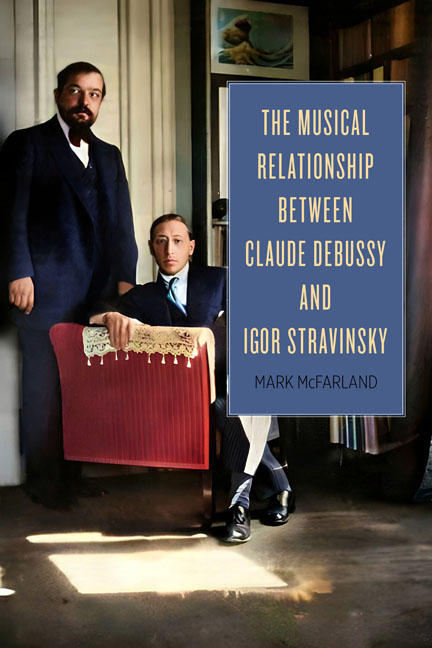Book contents
- Frontmatter
- Dedication
- Contents
- Acknowledgments
- Introduction
- 1 A Mutual Influence
- 2 Cinematic Montage and Stratified Form
- 3 Stratified Form in Debussy’s Works: 1909–1913
- 4 Debussy and the Chromatic Set
- 5 Stratified Form in Jeux
- 6 Stravinsky’s Waning Influence: 1914–1917
- Conclusion
- Glossary
- Bibliography
- Index
4 - Debussy and the Chromatic Set
Published online by Cambridge University Press: 10 May 2024
- Frontmatter
- Dedication
- Contents
- Acknowledgments
- Introduction
- 1 A Mutual Influence
- 2 Cinematic Montage and Stratified Form
- 3 Stratified Form in Debussy’s Works: 1909–1913
- 4 Debussy and the Chromatic Set
- 5 Stratified Form in Jeux
- 6 Stravinsky’s Waning Influence: 1914–1917
- Conclusion
- Glossary
- Bibliography
- Index
Summary
In addition to the whole-tone and octatonic scales, Debussy also used the chromatic scale in opposition with diatonic writing in his works from 1912–13. This use of the chromatic set becomes obvious in “Feux d’artifice,” where the complete chromatic is heard at the climax of the prelude as simultaneous white-and black-note glissandi. The question regarding this scale is quantity: What amount of the total chromatic is needed to imply this set? Further, does this set need to be tightly packed—without any gaps larger than a semitone—or can it simply be an atonal collection of notes? These answers come when Debussy's use of the chromatic set is explored as implying it in two distinct ways: through chordal superimposition and chromatic voice leading. I now explore the first of these techniques, specifically looking at which types of chordal superimpositions Debussy favored and how this technique was treated by contemporary theorists.
Debussy's First Chromatic Routine
In a harmony treatise written by René Lenormand before Debussy's death, the concept that the author had the most trouble with was superimposed triads. Lenormand wrote his treatise the year that Debussy published his second book of preludes, so he was unable to include these works in his list of examples from “modernist” works. This is unfortunate, because these twelve preludes openly use superimposed triads, and their presence might have caused Lenormand to study this phenomenon a bit more deeply. As it is, Lenormand favors high tertian spellings and the use of pedals rather than the superimposition of multiple triads, and when his two methods fail to properly account for a passage, he resorts to explaining foreign notes as appoggiaturas. In fact, the most famous example of appoggiatura chords in the trio of the seventh of Ravel's Valses nobles et sentimentales is analyzed in Lenormand complete with reduction to reveal the underlying harmony (example 4.1).
Lenormand admits that in these chords, born of appoggiaturas, “the suppression of the note of resolution of the appoggiatura is a recent practice.” Since Lenormand's time, theorists have preferred the label polychord, with the understanding that composers have most commonly partitioned the notes so that the chords are not only registrally distinct but each have their own unique identity in the form of a given inversion. This makes the single polychord audibly composed of distinct elements.
- Type
- Chapter
- Information
- Publisher: Boydell & BrewerPrint publication year: 2024



